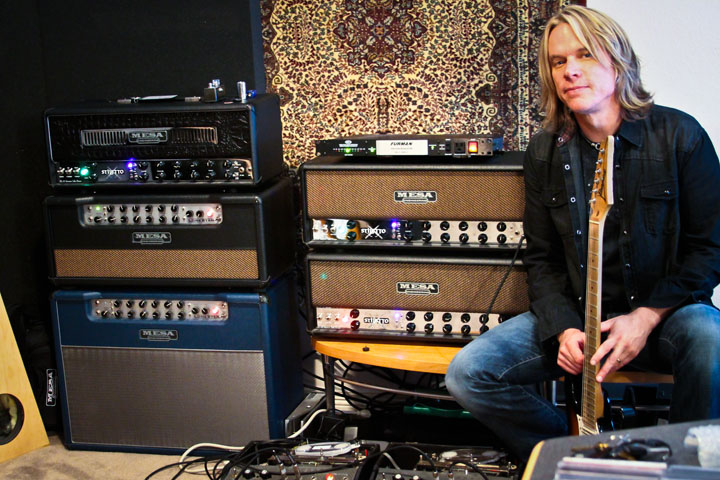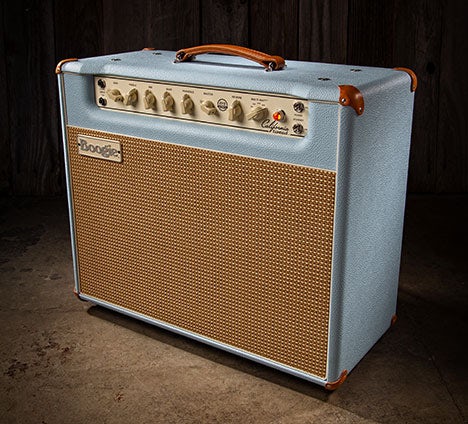Amplitudes: The Mesa Boogie Blog
Artist
Andy Timmons Interview ~ August 2010
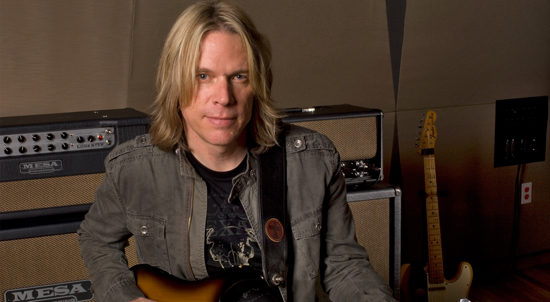
Amplitudes: Hi Andy – thanks so much for taking the time for this interview today.
Andy: My pleasure to be here – thanks for having me.
Amplitudes: As I understand it, you are currently in the studio with two album projects right now - one is the next link in your solo album chain and the other project has a very unique creative and historical twist in re-working a Beatles masterpiece, Sgt. Pepper. How are those projects going and are you working on both at the same time or one then the other?
Andy: It kind of came together in this fashion. I’m constantly working on new original material so there are always lots of new original songs being worked on and in the pipeline. While we were in the studio to record 5 or 6 songs for the new solo album, we ended up with some extra time and decided to record a project I put together two years prior, which was an arrangement of the Sgt. Pepper record.
The project began simply by doing a medley track of Sgt. Pepper into Strawberry Fields, which we had been doing in our live show. I’m not exactly sure what inspired me to do this at the time but it was just a fun thing to do and a challenge to see if I could pull it off with just one guitar, bass and drums. It was really going over well in our live show and it got me inspired to see if there was another Beatles track I could do…
Before I knew it, I was going down the path of rearranging the entire Sgt. Pepper’s record. It literally took a couple of years of me coming back to it over and over and thinking, if I’m playing When I’m 64, how am I going to pull this off? And because I am approaching this exactly like I did on the Resolution CD where I’m recording it with only one guitar pass on the whole song, its challenging to say the least. So, what you’ll be hearing is just one guitar playing whatever melodies, chordal context, orchestration – whatever is at the forefront of my memory of the music is how I arranged each piece.
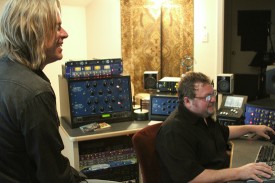
Andy & Engineer/Co-Producer Rob Wechsler in the control room
So when we finished the original tunes a few days early on the latest studio sessions, Rob Wechsler, my co-producer and engineer asked me if I had anything else I wanted to do. I had all the arrangements done but I hadn’t shown them to the band yet. We quickly got through Sgt. Pepper and Strawberry Fields, having played them before, but then I had to show the band what I had in mind for the remaining 12 songs.
Long story short, in 3 days we laid down all the basics to the songs, which is a great tribute to Mitch Marine, my drummer. He knew the material so well coming into it – like I did – and he nailed everything and the feel was wonderful. He’s one of the few guys out there that really understands the beauty of Ringo Starr and how great those parts are and why those songs feel so good.
We got about half of the guitar tracks on those sessions and after listening back, I wanted to re-cut about half of those. Over a period of time - actually just last week - I finished up those tracks and I’m really happy with them. Now we have a few bass tracks left to do and it’s going to be done. Probably later this year I’ll get back to working on the original tunes.
Amplitudes: The Sgt. Pepper project sounds like a tremendous undertaking, especially with as many important parts to consider within those great songs…
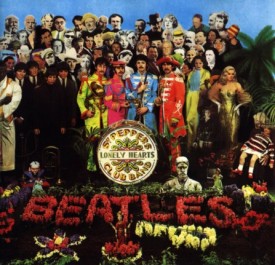
Andy: It is. And I should probably point out that the way I decided to approach this was to do it from memory. I decided that if I was going to try to pull it off with one guitar pass I wanted it to be the way that I remember that music. I should also point out that I’ve listened to the Beatle’s music as much as is humanly possible. But it’s been that way for so many people – it’s such a soundtrack for our lives. I’ve been immersed in it since I was born in 1963 and I have three older brothers – one who was 12 at the time. Basically, many years of my life have been filled with that music.
So this was kind of a cool thing for me to let it be as I remembered it. After we recorded it and when I finally went back and referenced the music, there were a few different things… Like finding out, wow, that’s a completely wrong chord or, that didn’t happen in the song originally, but it was how I perceived it in my memory. You know how sometimes you might remember a lyric or part in a song incorrectly over the years… But I wanted to keep it that way because I really wanted it to be my honest interpretations of this music from my memory and experience. So in that regard, its really got a special energy and joy about it. I’m not trying to imitate or sound exactly like the record – and partly by virtue of that being impossible on the guitar, for one thing. So it was a lot of fun and very gratifying to get this on track, so to speak.
Amplitudes: So, just to make sure I understand it correctly – did you intentionally avoid listening to the music to preserve your memory of it?
Andy: Yes! It just felt like the most natural way to approach it. Everybody’s musical memory is different but when I’m hearing a song, I’m not necessarily hearing all the layers of a song at once but maybe a vocal line for a minute, then a guitar line sticks out, then there’s a trumpet part that peeks out or an orchestral section that jumps to the front of the mix and to my attention. So my thinking early on was, if I have to cover so much in one performance, I’ve got to cover the highlights – I can’t cover all the parts at once, although sometimes I’m incorporating elements of orchestration, vocals and chords, guitar parts – whatever I can humanly fit in. But doing it in this way was really cool for me and in some ways I think it made it a lot easier. Approaches like, here’s the melody, now how am I going to support that from what I remember of the recording. And then trying to put in fun stuff like noises, vocal ad-libs, or, the animal noises from the end of Good Morning, Good Morning. Stuff like that was a blast to see if I could get the sounds happening.
Amplitudes: Maybe a good time for the Floyd Rose for some of the animal noises, huh?
Andy: Actually, I recorded almost the entire record with my AT100 signature model and my original prototype from 1994. While that guitar has a very vintage style tremolo made by Trev Wilkinson and is not set up for floating, I was able to bend back a little bit. So it was all done on that guitar except for When I’m 64, where I used my ’68 Tele. I had the idea of approaching that song like George Harrison’s rockabilly tone when he was playing the Gretsch in ’64 – like on Baby’s in Black or Eveybody’s Trying to Be My Baby – that kind of Gretsch-y tone. I have a ’62 Gretsch Tennessean but when it came down to it, my ’68 Tele in the middle position sounded Gretsch-ier than the Gretsch did (laughs).
So I plugged the ’68 Tele into a Carl Martin compressor and the two Lone Stars split with a Fulltone Tape Echo and really got a wonderful, vintage rockabilly tone. I don’t want to give it all away but that’s how some of the song was recorded – sonically – and it has some other elements as well.
Amplitudes: Well, on the follow-up interview after the release we’ll have to focus in on the making of the animal noises and other sound effects for this album…
Andy: (laughs) Yeah, I can’t wait for everyone to hear it. There will definitely be some good laughs on some of that stuff.
Amplitudes: This might be a great segue into your recording process between these two albums. Are there any differences worth mentioning?
Andy: Well, honestly, the two albums aren’t approached all that differently. The Sgt. Pepper’s album has gotten a little more of a push lately since it’s closer to being done. I decided to focus on what I thought I could finish first and make it really special seeing it’s been a while since our last album, Resolution, was released. But, both are actually approached very similarly in keeping the guitar to a single part and tracking the bass, guitar and drums live. This has been the way I approach the writing and the recording for quite a while.
Amplitudes: So we’ve talked a bit about how you came up with the style of both your live playing and recordings in the trio format. Can you expand on how that style evolved and what got you into that approach and how it’s been refined over the years where a single guitar track carries the tune throughout, seamlessly combining melody and chordal harmony.
Andy: It’s not that it hasn’t been done before – there have been plenty of guitarists playing in the trio format doing things along this line. I personally hadn’t done it to the extent that I’m doing it on the Resolution CD and it actually stems from a conversation with Steve Vai.
Several years ago he released a record of mine called That Was Then, This Is Now, which is kind of a “best of” compilation, comprised of songs from some of my earlier records plus four new tracks. When I turned the four new tunes into Steve to check out, there were certain sections where there was just bass, guitar and drums. He commented to me how he really loved those sections and how he could really hear everything - Especially just the one guitar, hearing the fingers on the frets and how it was such a cool sound in general. So that was tucked away in my mind like it would have been if it were a compliment from my older brother or something. Any kind of positive, supportive comments like that I tend to really hold onto, as most times it will really help you down the road.
So when we started working on the Resolution CD, we’d recorded basic tracks like I would have from many of my previous records. I’d go in playing what I figured would be the rhythm guitar part and thinking that I would overdub solos and melodies later. We finished those tracks and then went on tour. Weeks later when I started listening back and preparing to finish, I became completely uninspired. It sounded really tired and left me feeling like instrumental guitar music had been so overdone by that point.
Then I thought about what Steve (Vai) had said and wondered if I could do a whole album like that… Actually pulling off a whole album with no overdubs – one guitar part incorporating all those ideas like playing the melody, the solos and the chordal ideas in the same track… and that’s when I got excited. That’s when I knew I had a challenge of something I hadn’t done yet that was likely to bring different flavors out of my playing and would really kick my butt – which it did! I really had to reinvent how I was doing things. It took a while – I really had to work a long time on the arrangements but once I got things into a place I was really happy with them and it was smooth sailing. So I’m just kind of continuing that. I enjoy the process so much and continue to learn and grow from it – it just keeps growing further in that direction.
Amplitudes: Can you share any of your favorite recording techniques for readers? What kind of preparation do you make for playing a particular track or project?
Andy: Absolutely – and that was the beauty of the Sgt. Pepper recordings. By the time we went in to record, I had a really good idea of how I was going to the play the parts, although there were also many great moments of improvised interplay between the band. Some of the things that happened were really fresh and I knew I could never replicate them. But there’s a lot of preparation that goes into it as well.
As far as the Beatles tracks were concerned, I’d done A LOT of work leading up to the recording and knew the material pretty well so that made it pretty easy. From the original stuff there were some songs I hadn’t done much work on and some of those elements are a work in progress. I’ll continue to tweak on those. But sometimes the goal is not necessarily to get my parts but to make sure that we get great bass and drums tracks laid down. If I’m not happy with my part, I know I can redo it until I get happy with it and make it mine.
Amplitudes: Any favorite mic’ing techniques you employ or other studio tricks that you’d be willing to share with readers?
Andy: There are several things for me, dating back to the Resolution sessions with Mike Daane (bass player). We tried every mic possible and every technique and always came back to the SM57. And, as Mike would say, the cheapest mic wins (laughs).

Working with Rob Wechsler, my longtime engineer who has done the majority of my stuff since 1988, he likes to use an SM57 on a lot of things and we also used a Beyer-Dynamic 160, which is the old Eddie Kramer/Jimi Hendrix mic that Eddie used on quite a few of Jimi’s recordings. There are also a few mic’s that we used that were from my collection. Rob asked me what mic’s I had laying around so I brought some of my drum mic’s – I think it was an Audix D2 that was used on one or two of the amps for some tracks and it sounded great.
Which leads me to something I want to point out. Because my whole recording approach is only a single guitar performance we generally record everything with at least two amps on at the same time. I set the amps to slightly different settings to give more of a panoramic soundscape rather than a dead center, one-track kind of tone. This approach helps to give the single guitar performance some space and it grew to even more amps over time. Sometimes I’ll have my larger Mesa/Boogie rig with two stereo rigs – two Lone Stars and two Stiletto Deuces. Most of the Sgt. Pepper record was recorded with those four amps on all the time.

Amplitudes: Is this also with various delays on some or most of the different sounds you work with live?
Andy: That is a part of the sound and it’s one of the tools we use to give it some of the imaging we like. The way this is best accomplished to my taste is using different delay times to create the imaging on the left and the right. Generally, and depending on the song tempo, if you use 375 milliseconds delay on one side and 500 milliseconds on the other, its gives you sort of a dotted eighth/quarter feel. And that really gives a nice aura around the note and can really help you “sing” the note through the guitar.
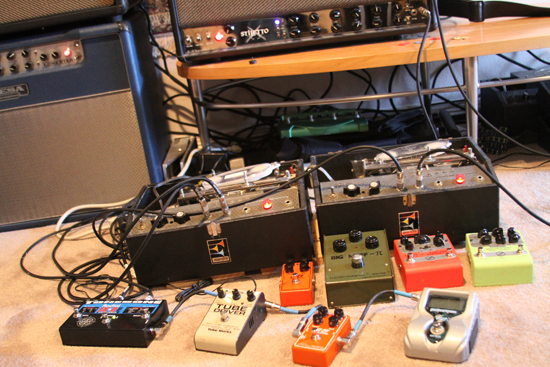
Peterson StroboStomp II Tuner Pedal
Exotic Andy Timmons Signature BB Preamp Pedal
Tube Works Tube Driver Pedal by: B.K. Butler
Vintage Electro Harmonix Big Muff Pedal
GNI Multi-Fuzz Pedal (for Octavia effect only)
GNI Analog Stereo Dual Chorus Pedal
Vintage Maestro Echoplex Tape Echo
Radial JX-2 Pro Switchbone Amp Switcher/Combiner Pedal
So that’s the general formula I use. In the studio, I generally prefer to do it with the tape echo. I very rarely record with digital delays these days since I have a couple of old Maestro EP3 Echoplexes. Occasionally we’ll run one of the old Chandler Digital Echos – they have a nice sound and you can add chorus to the repeats. Similar to those is the old Electro Harmonix Deluxe Memory Man pedals that I like for an analog approach and still use in my live rig.
Most of this record was the Echoplexes but when I was tracking through the Lone Stars, I would occasionally use a T.C. Electronics G-Force. Some of the Beatle harmony sounds utilized a technique they were into at the time called automatic double-tracking (also referred to as ADT). They were manipulating the tape in a way that, as they recorded something, it would kind of chorus and flange it out a little bit. They did this on some of their vocals and on some guitar parts as well. If you listen to the guitar sound on A Little Help From My Friends, it’s clearly used there. It was a common technique for them and sounds great.
So for me to replicate the way the chorus comes in on Sgt. Pepper, which comes in with this wonderfully layered vocal sound, I’d add a bit of chorusing with the Lone Stars to make it sound a little wider, while keeping the Stilettos more dry with just a bit of echo. It ends up sounding like I’ve overdubbed a couple of guitar parts where it’s just this single performance. You can create a HUGE tone this way for both live and recorded stuff.
Amplitudes: So, on the subject of amps, what can you tell us about your settings on the Lone Stars and Stilettos in the studio and how those amps served in the recording environment?
Andy: I’ve been using the Stiletto and the Lone Star so much over the last 5 years that it basically remains constant at this point. The settings that I’ve gravitated towards tend to stick.

With the Lone Star, if I’m on the clean channel, a great place to start is straight up – 12 o’clock on the EQ settings, with the exception of the bass. The bass on both of the Lone Star channels is pretty awesome so you don’t need as much on the knob as you would on a lot of other amps. On the clean channels, I usually have the bass at just a little less than noon. I do hit the front of the Lone Star’s clean channel with a Carl Martin compressor but not really set in a compressing capacity, but rather an input boost.
On the lead channel, I turn the compression off and I’m just going straight into the amp with Drive engaged and both Drive and Gain set somewhere close to 3 o’clock – I then season to taste with Presence, Treble and Middle. The Bass control needs to be set very low when the Drive and Gain are set that high, which is actually awesome because it’s the first amp I’ve ever had where the Bass has to be turned down!! Most amps I’ve used over the years, you’d have turn the Bass all the way up and Treble and Presence OFF just to try to get a really fat, warm singing lead tone. Just plugging straight into the Lone Star, I’m dialing Bass down a bit and adding Treble and Presence. It has an amazing top end that is never harsh or biting. It gives me lots of room to explore all the tone controls for the different instruments I use.
The Lone Star also has a nice amount of gain, but… not TOO much where it gets buzzy like a lot of amps do with the gain set high. It also takes pedals really well so sometimes I’ll hit the front end with a gain pedal. I love the BB-Pre pedal by Exotic to add just a little bit of gain to push the front end for certain sounds.
So for the Lone Star, that’s basically it. Different gizmos occasionally make it into the mix like a GNI Octavia pedal or, I used a Big Muff on a couple of tracks – the old, green Russian Big Muff. I’ve never really used fuzz much before but I’ve really grown to love that sound.

Then, running the Stiletto – that’s a whole ‘nuther animal where I’m really able to replicate the sounds I got on the Resolution record where its got that British type of circuitry. A lot of the lead tones are actually on the clean channel, sometimes on Tite Clean and sometimes on Fat Clean. I run an old Tubeworks Tube Driver into the front of the clean channel, usually with a tape echo in-between and that’s the tone. I start with everything straight up on the EQ controls and season to taste depending on guitar and other aspects. Volume and gain are probably about half way up.
For neck pickup, broken-up kind of tones, I love to use Tite Gain on channel two of the Stiletto. Ironically, this mode cleans up beautifully as you roll your guitar volume down. When you hear the way I recorded She’s Leaving Home, it was very similar to how I recorded Resolution and the Prayer and the Answer on the last record. It was kind of a gained up sound but with the volume knob rolled way down on my guitar. While it has an amazing high-gain sound, its got a beautiful clipped, sparkly, shimmering tone and that’s the sound I used on the solo of She’s Leaving Home.
Amplitudes: Are you the type of player that uses your volume control on the instrument to dial in and refine your tones as well as pulling out different textures and tones and gain flavors?
Andy: Absolutely! There’s so much you can do with this approach and it’s an overlooked technique for tone. If you watch what I’m playing I’m on the volume control a lot for different phrases and trying to get the notes to speak just a certain way. So it’s very important for me to have a good volume control and filter cap on my guitar so that as I turn down the volume on the instrument, it retains the top end clarity. Without the filter cap the sound will get muddy when you roll the volume down.
Amplitudes: It’s likely that a lot of people don’t understand the potential for tone when using their volume knobs because the circuit on their guitars isn’t set up right to deliver the kind of functionality you mentioned. It’s such a powerful tone control when set up correctly.
Andy: Exactly. I couldn’t agree more and it’s a huge part of my tone.
Amplitudes: We’ve also heard that you are a newer fan of open back Lone Star cabs. Can you explain the differences you hear between open and closed back cabs and where either is more useful in recording or live?
Andy: It was inspired by my memory of my very first time plugging into a Lone Star, which was a 1x12 combo. I don’t know if you know the story but Steve Mueller, (Sales GM for Mesa and longtime friend of Andy’s) had one of the early prototypes that Randall Smith (Mesa’s founder, Designer and President) had personally built…
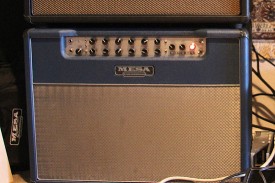
Amplitudes: Is this the infamous Lone Star #13?
Andy: (laughs) Ahhh, yes, the now infamous #13!
Amplitudes: Lucky #13 we might say…
Andy: Yeah, I think so … So, Steve had this amp and I’ve known him for many years. He’s always been really great and I’ve been fortunate to get some sneak peeks and information about new amps that are being developed. Over the years, I’ve loved Mesa amps anyway… Some I’ve really connected with, like the Maverick. Then some just weren’t necessarily my sound. Obviously, with anything in music, that’s just the way it goes. But he was telling me about the Lone Star and brought it to a studio session I was doing to check it out. I said, “you know what, I’ve got a gig tonight so let me just take it out.”
So I took the amp out without really having played it for longer than 10 minutes at the studio. It was the 1x12 combo but I also had a 2x12 Recto closed back cab I set it on, so I had the closed back and the open back of the combo working together. It ended up being one of those glorious nights where everything lined up! The tone was great, I played pretty well and the crowd was totally digging it. After the show people were coming up to me like crazy saying things like, “That was the best tone you’ve ever had!” and I knew at that point I was sold!
But the other part of the story was that I was endorsing another amplifier company at the time and they were working on a signature amp for me… I knew I had a difficult phone call to make after that first night with the Lone Star! I also knew that at every point in my career, whenever I made a decision based on business, it ended up being the wrong decision… So, after some deep thought, I decided that I have to play what I want to play and it turned out to be the right decision.
Ever since then, my career and relationship with Mesa has turned out to do nothing but blossom and grow – and – it’s genuine, which is REALLY important to me. I tell people when I’m traveling around touring that there’s no piece of paper between Mesa/Boogie and me saying, “you must play these amps and you will promote these amps” (said in robot voice).
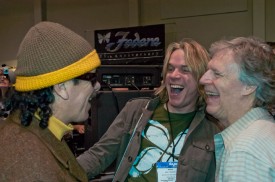
Mesa’s all about, “Do you like our amps? If you do, GREAT! Play ‘em. And if you don’t, that’s cool too…” But they are quick to get outside insight and are always looking for ways to improve. It ends up being this “kindred spirit” kind of thing where I feel it from all the people that I know at Mesa, from Randall Smith on down.
At the end of the day, we are in a business, and its unfortunate that sometimes music has to be about business, but the reason many of us are still doing this is because it’s about the music and the integrity involved in that art form. With Mesa, it’s really good to see that there are still people that do things because they love it and not just because of a paycheck. And for me that really shines through in everything Mesa does. It’s become my credo and it’s how I’ve conducted my business after a certain point in my career… I just want things to be for the right reasons and not just about the business.
So, from that point the Lone Star was my amp! Unfortunately for Steve Mueller, it was that specific amp I had my heart set on. Steve said, “Well, yeah, if you love the amp, I’ll order one for you.” But I stopped him and said, “But Steve, I really want THIS amp”. I kind of insisted but I didn’t learn until years later that this particular amp was one of the final production prototypes that Randall Smith had worked on himself and had given to Steve as a gift. But Steve was so stoked that I loved the amp so much that he arranged for me to buy it. I obviously didn’t know at the time what the deal was with it but once I did, I tried a number of times to give it back but he won’t have it.
But that was the thing with the Lone Star, my memory of that first night. Part of the special thing was the tone of the open back cabinet. Especially on the clean sound when I play my AT100 with single coils for country tunes like Headed for the Ditch or Farmer Sez, the Lone Star open back cab is so wonderful for those tones. There are times now when I use one of my Lone Star Heads on top of a Lone Star 4x10 open back cab along with my Lone Star 1x12 Combo. As a stereo rig or by themselves they sound amazing!
Amplitudes: Beyond Lone Star Combo #13, can you elaborate on the consistency and reliability you’ve experienced while on the road with Mesa backline and different amps of the same model when your personal amps aren’t available?
Andy: It’s a great point to make and it’s again, why I’ve tried so hard to give the amp back to Steve!! (laughs)
My previous experiences with amp consistency were mixed at best. For example, prior to using Mesa, I was on tour in Europe and the amp I was using died. I was fortunate to be in a town where I knew someone who owned a music store and he let me use whatever I wanted from his shop. I found an amp that was amazing and later decided to buy one of that same model… Unfortunately, the one they sent me sounded nothing like the first one I played. So, from then on, I’ve always had the impression that if you find that “special one” you don’t let it go.
Fast forward to now… Most times when I’m touring or doing clinics in the U.S. or abroad, I’m either using rented Mesa backline, or in the case of a clinic, using the Dealers stock inventory. I’ve always been able to get my tone from any of the amps provided in those situations.
I dial in the settings we talked about earlier and adjust by ear. Of course, every tube-set is likely to be a little different depending on lots of different factors, but man, its always there. I’ve always been able to get my tone anywhere I go. People often have the impression that I’m traveling with my “one” specific amplifier but that’s not the case. When you see me on the road, it’s rarely my personal amps and cabs. If you see me in Dallas, OK, those are my amps and cabs! (laughs). Anywhere else and it’s coming from local stock and they’re not modded or specially made for me. They’re what everybody has available to them which is really great and again, another reason why I’m proud to be out there promoting Mesa amps and cabs.
On the current clinic tour, it’ll be different amps in every music store. And it doesn’t take me long at all to get the amps right where I want them. It takes me longer to plug in all the cables than it does to dial in the amps!
Amplitudes: Season to taste, as you say…
Andy: Yeah, man. That’s it! It’s easy to do with the consistency between the amps. I chalk it up to Mesa’s build quality and use of extremely tight tolerance parts in each amp as just a few of the things that make it so easy.
Amplitudes: That leads us nicely into a conversation about how you’ve been a significant reference point in the R & D process on a couple of amps from Mesa, most recently the TransAtlantic. As an owner of many prized vintage amps and someone who understands how those amps work to deliver the sought-after tones, can you tell us from your perspective how the TA-15 first got to you and share some of your experiences working with Steve Mueller in A/B’ing to your personal collection of vintage favorites?
Andy: Well, as with anything, when Steve tells me about whatever new stuff they are working on, I get excited about it. Like what happened with the Stiletto and being involved with that a little bit. It’s a wonderful position for me to be in and I’m honored that my ears are involved on some level.
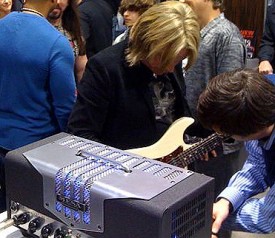
When Steve told me that they were working on some other vintage-y kind of things, especially the AC-30 and original Vox type sounds, I was all ears. I have a 1964 Vox AC-30 with Top Boost, which over the years, has been one of my main tracking amps. Not as much for my own stuff, but when I’m doing session stuff like pop vocal records… When you need that good, jangly clean but still slightly broken up tone with a Strat or a Telecaster. That old circuit just sounds so amazing for that kind of stuff and obviously so many great records in the 60’s and years forward were recorded with it.
Steve knew that this is one of my “go-to amps” for a lot of session work so he spent some time here at my studio listening to that amp and getting my feedback on things I liked and didn’t like about it. He was also the live guitarist for an artist I had done a bunch of session work for and used that amp pretty extensively on it as well. He had to learn all my guitar parts from that session so he studied that material and the tones I used extensively. He never really let me in on any of the earlier versions of the TA-15 because he said he wanted me to hear it when he thought it was ready and right.
It’s pretty cool that it happened that way because I’ll never forget it. I went over to his home studio and he had it set up. I took my old Telecaster over there and plugged in… I literally teared up! (laughs) It was funny… I was so overwhelmed at how great it sounded!
It was a really cool moment because I knew within two chords that they’d really gotten it right. It just had the shimmer and the body and the right amount of gain… and it was just stunning – nothing short of greatness! So I was laughing at this great moment and then Steve says, “Well check out this mode” (more laughs). And then it does this wonderful kind of Blackface Deluxe thing on channel 2, which, I also own a vintage original of and have recorded with extensively – It’s another sound I really love and it was over the top on the TA-15!
At that point I said, “You could have stopped at channel 1… but no.” Then, there’s this amazing British crunch in channel 2’s gain modes… And all of this is in this 12lb., tiny little amplifier. I was just blown away and so impressed with what had been done in that tiny little package. I’m really looking forward to spending some more time with it and doing some recording with it.
Amplitudes: Well, we’ll be looking forward to hearing what you record with itas well! Will you be doing any demos with the TA-15 at your clinics and can you tell us what people will can expect to experience at one of your clinics?
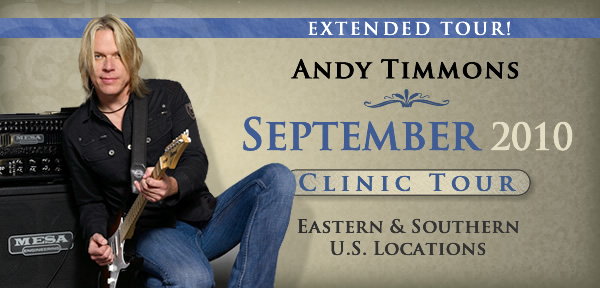
Andy: The fun thing is that no two clinics are alike. I never have a preconception of how things are going to go and I really try to gear things towards the audience that attends. I try to get a feel for what they might enjoy most. But one thing they can count on is a lot of playing. I know that when I’ve gone to clinics, from my youth up to present day, I always want to see and hear how that musician is doing what they do. So I tend to set it up as half concert, and half hanging out, like we’re in their living room chattin’. I like to open things up for questions throughout the night and I stay open to it going in any possible direction. Obviously, we’re mainly talking about the amps and guitar playing, but it can also be about the music business or about where the best Mexican food in Dallas is! (laughs)
Really… I’m just so happy to share any aspect of my career over the years. It’s so much fun to pass that on. There are kids that show up as well as guys that have been playing a lot longer than me and we all learn from each other. That’s the cool thing about music and specifically the guitar. It just seems like such a wonderful community of players who are both open to new ideas and also willing to share what they know. I get to see this in so many different cities and meet so many great players in the process. If I’m in the position to be able to inspire other players, whether they’re younger or older, it’s an awesome privilege for me and I have a lot of fun doing it! I get to play my music and spread the word about that and what I’m doing musically, and I get to let people hear these awesome tones coming out of Mesa amps and cabs. (smiles all around).
Amplitudes: Aside from these upcoming clinics, any plans for live touring this year and when fans can expect some of your new stuff to hit the airwaves and CD shelves?
Andy: We’re gonna be in Japan later this year but it’s all going to depend on when the record comes out. For now, I can say that the Sgt. Pepper record will be out sometime toward the end of 2010. There are still some things for me to put in place as far as getting the right promotion together and the specific way I’d like to release it. There are a few more details to work out but I’m in a good place now that I’m happy with the recording and feel that it really stands up.
My initial trepidation was that this is hallowed ground… The Beatles catalog has been done and redone so many times and if I’m being honest, I’d have to say that I’m not the biggest fan of Beatle’s covers. I am the biggest Beatles fan, like a lot of people, but it’s got to be done… uhhh, it’s hard to explain… Let’s just say it’s hard to get it out there in the right way. The initial response I’ve received from those who have heard the current tracks so far has been great. Everyone seems to be getting where I was coming from on it. There’s a lot of joy and passion in it. I didn’t try to reinvent the wheel; I’m just trying to reinterpret it through my musical memory. It took me a while to get the confidence that it was going to work. It’s such a major undertaking and if you’re not doing it in a unique or special way, then why do it at all. I’m just hoping that people will perceive and experience that when they hear it.
Amplitudes: Well, the concepts themselves are creative and engaging and there’s some really good history of you bringing some exceptional execution to the table… So with the two combined, I think we’re gonna be on board for a nice ride on this one Andy! We’re really looking forward to it. Anything else you’d like to add before we wrap this up?
Andy: I think we’ve covered a good amount of ground here. The records are both moving along nicely and I would love to meet as many people as possible at the upcoming Mesa clinic tour – it’s a lot of fun. And I think they’re free, right?
Amplitudes: Yes, sir – they are free.
Andy: It’s a great price, that free business… (laughs) And hopefully we’ll be able to get some touring done and see some more people out there when the Sgt. Pepper album comes out later this year.
Amplitudes: We’re looking very forward to it. Thanks so much for your time today, your integrity and musical artistry! On behalf of a dedicated fan base and everyone at Mesa, thanks for doing what you do and for flying the Boogie flag so high!
Andy: It’s my pleasure! I’m looking forward to seeing you all out there later this year. All the best!